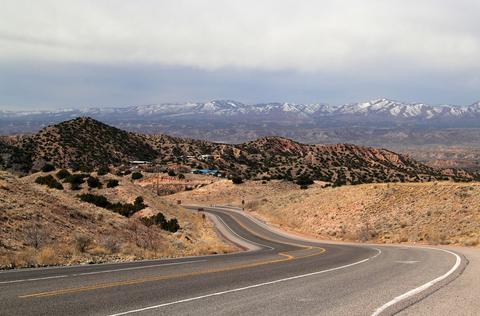 The further north you drive out of Santa Fe the further back in time you go. The road roughly parallels the Rio Grande, the mighty river. A Southwestern landscape. There are better roads now but not much else has changed. The old Native American settlements that you pass, Tesuque and Pojuaque might as well exist in a parallel universe.
The further north you drive out of Santa Fe the further back in time you go. The road roughly parallels the Rio Grande, the mighty river. A Southwestern landscape. There are better roads now but not much else has changed. The old Native American settlements that you pass, Tesuque and Pojuaque might as well exist in a parallel universe.
The rolling dun-colored hills that rise up on either side are accented with green dots of piñon and juniper. They haven’t changed much either since Georgia O’Keeffe immortalized them on canvas back in the mid-1960’s. She was in love with them. And they were in love with her.
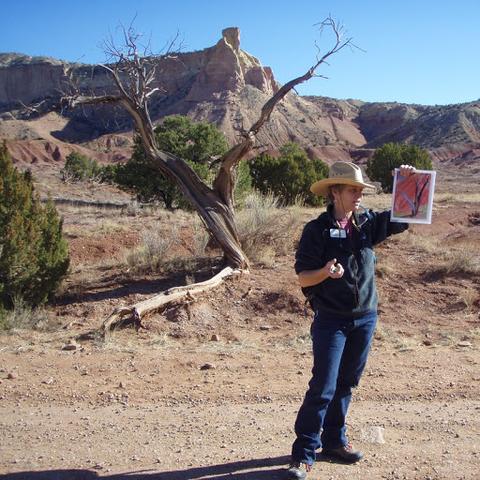
“Her shadow snakes across the Southwest…” as Tom Russell writes, “Her spirit circles around Taos and Santa Fe.” We could not have known it then but she would become our touchstone. Our role model for holding dreams fast. More about her later.
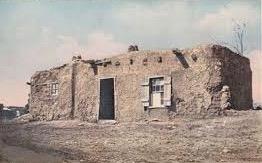 Here and there are old houses in among the trees, some of them adobe and some of the adobe bricks are crumbling, returning to the earth. Some have vigas sticking out of the walls, supporting the roofs in the age-old Southwestern style.
Here and there are old houses in among the trees, some of them adobe and some of the adobe bricks are crumbling, returning to the earth. Some have vigas sticking out of the walls, supporting the roofs in the age-old Southwestern style.
JoAnn and I were on our way to Chimayo, more properly Santuario de Chimayo, an old church north of Santa Fe that had an irresistible back story and was reputed to have wonderful healing powers. Some called it the Lourdes of North America. We had heard it was not to be missed. So of course it was one of the first places we went.
Santa Fe was our first real excursion since we had become a couple. It had only been a few months since we had rented the tiny, yellow batten board cottage in Corona del Mar. I had only been to Santa Fe once before but the city had become precious to me and I wanted to share it with someone I already thought of as a soulmate, show it to her like I would show off a precious jewel, hoping she would like it, love it, as much as I did. We had flown into Albuquerque, rented a car and drove up to Santa Fe and when JoAnn emerged from the car in front of La Fonda Hotel, looked around and said: “I think I’ve lived here before,” I knew soulmate wasn’t strong enough.
In those pre-GPS days you had to rely on maps. Once you left the main road there were no clear signs and every fork in the road was a question: Right? Left?
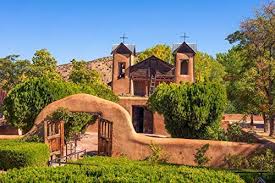 And then, suddenly, there it was. Tucked in among the trees, standing guard over a green meadow rolling away, its weathered adobe presence and rough hewn beams speaking of simpler, quieter times.
And then, suddenly, there it was. Tucked in among the trees, standing guard over a green meadow rolling away, its weathered adobe presence and rough hewn beams speaking of simpler, quieter times.
Before the Spaniards arrived, a hot spring that flowed near present day Chimayo was sacred to the Tewa Indians for its healing powers. The place has a history. Legend has it that more than 200 years ago a shepherd saw a light coming from the ground. Digging into the dirt with his bare hands he found a cross and brought it to the local church where the priest, Father Alvarez, placed it on the altar. In the morning it was gone, back into the spot where the shepherd had first discovered it. That happened again the next day and after the third time it happened Father Alvarez decided to build a chapel on the spot to house the crucifix.
The santuario itself is simple adobe, the colors of the earth and of the hills, rounded corners, small wooden crosses over the unassuming entrance. A place accessible to all. Perhaps the size of a large, one-room schoolhouse. A churchyard in the front encircled by a low adobe wall. Inside it is all dark woods and candles and santos. A handful of people sitting in the pews. A few women dressed in black.
Off what would be the transept to the left is a doorway to a small, low-ceilinged room that must be accessed by bending over. In the dim light you might miss the even smaller room off to the right with a depression that contains the healing dirt. Here you speak in whispers. Discarded crutches, pictures of sons, husbands, brothers in uniform line the rough adobe walls. Taped. Asking protection from a loving God. Imploring God for grace. For protection. For healing.,
The santuario crept its way into our pores the way Santa Fe had. We knew we were looking through a window into eternity. I don’t know how long we stayed but when we finally walked back out, squinting into the brilliant sunshine and the impossibly blue New Mexico sky, when we blundered our way back to Santa Fe down a few dead ends we knew we had been changed. In some inexplicable way we would never be the same.
But Santa Fe wasn’t finished with us. We found a parking spot on one of the narrow old-world streets of the old section and walked over to Water Street and up the narrow staircase to the Rooftop Cantina of the Coyote Cafe, epicenter of the place that would make New Mexican cuisine famous, and ordered a Margarita, grasping for the familiar, and let the sounds and the smells of the city wash over us.
This is as good a time as any to say that calling Santa Fe as a “city” does not do it justice. At all. It is a city in the sense that it is the capital of New Mexico and home to way too many government offices and hotels. It is an art center, a center of culture. Natives are fond of saying: “They were born here their whole lives.”
But with its narrow streets and absence of building much over three stories, with its population of about 70,000 back in the 80’s and its eclectic combination of backgrounds, Native Americans (Navajo, Tewa, Pueblo, whose people have been living there for 5,000 years), Spanish (many of whom trace their families back more than 200 years), gringos (a lot from the East Coast), Mexicans (who have lived in the area for hundreds of years), Catholics, traditional (and of diverse persuasions such as Pentacostals, Penitentes), Conversos, (descendants of Jews who came in the 15th century to escape the Inquisition), it has retained the cachet of a large small town off the beaten path in Spain or Portugal, a wildly dysfunctional, friendly, welcoming large small town.
The cantina helped bring us back to the present. We decided we had fallen in love. With Santa Fe. That we would come back soon. We were going down the rabbit hole that must have effected Georgia O’Keeffe the same way in 1917 when she said sixty years later: “From then on I was always on my way back.” What better role model could there be?
Gotta go.
It has been several weeks since I last published one of these. We have been busy. I am now back on schedule. If you would like to receive more please sign up here.
